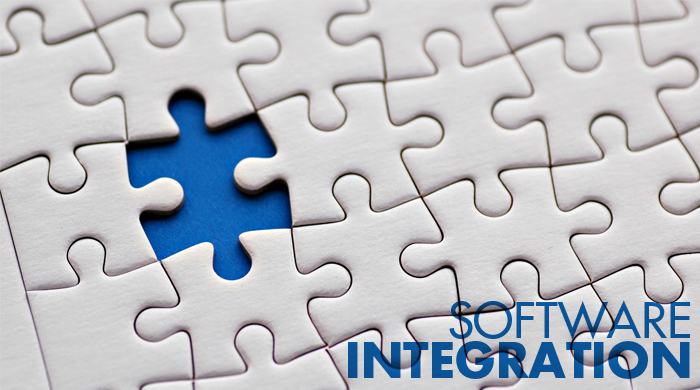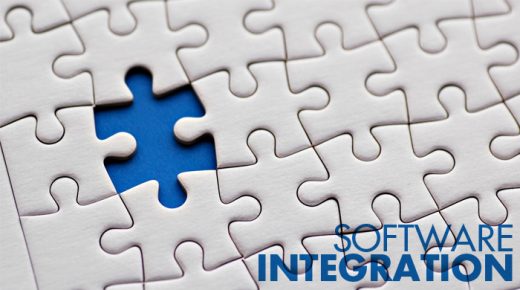Software Integration: The Basics for SaaS Users
October 5, 2016

As the number of cloud or Software as a Service (SaaS) applications that wholesale and B2B companies use increases, an important business challenge arises. How do you get information out of all those disparate systems that your organization may have adopted and put it into your main system of record, whether that’s a backend ERP or bookkeeping system, or some other application? The answer to this question, of course, is software integration: in this case, integrating your SaaS applications on the cloud with the other applications that you may be using to run your business.
The Basics of SaaS Software Integration
In this article, we’ll talk about why software integration for your SaaS applications is important for your business and some common methods of integrating your SaaS applications.
Return of the Data Silos: Why Software Integration Matters
When ERP applications were implemented in large scale during the 1990s, one of the most important benefits they delivered was the centralization of data. They replaced multiple departmental applications with a single system of recording all of a company’s important business data.
ERP largely lived up to that promise, at least until the rise of SaaS applications. Due to their relatively low cost to implement and ease of use, SaaS applications are proliferating on user desktops and mobile devices faster than most IT departments can keep up with.
SaaS applications are often adopted by individuals or departments within a company without necessarily being integrated with other systems. This model of adoption, sometimes referred to as “rogue IT,” occurs when new technology offers such improvements to current processes that users won’t wait to go through normal channels. The widespread use of applications like DropBox to share and store files is one common example of a user-driven “rogue” implementation.
While SaaS applications have significant business advantages, rogue implementations create a challenge when data remains siloed within the application, only available to certain users or departments.
To avoid this situation, software integration between SaaS applications and systems of record is important. These integrations may take one of two forms. The first is the software integration of cloud applications with on-premise software, for companies running older legacy systems. For companies with more modern systems, software integration involves connecting various applications running in the cloud.
Data silos reduce efficiency, annoy customers, and prevent accurate data analysis and reporting. Software integration matters because it ensures that the data in disparate systems is available to those who need it in systems of record.
SaaS Software Integration Tools
Depending on the type of integration your company needs to do, there are several software integration tools that can connect SaaS applications with on-premise systems or with other, cloud-based applications.
On-Premise Cloud Software Integration
The tools used for software integration between on-premise software applications, typically an ERP system, and cloud applications vary according to the systems that are being integrated with SaaS.
Many of the largest ERP vendors, such as Oracle and SAP, have developed their own tools—called integration platforms or middleware—to move data in an acceptable format between the ERP application and any other software that needs to be integrated. There’s also an entire category of middleware platforms to perform this task for those software applications that don’t provide their own solution.
There are also several web-based solutions for integrating data between platforms. APIs (such as the Handshake API) are among the most common tools for integrating data between cloud applications and on-premise or cloud-based ERP software. The beauty of an API is that it integrates only the data that is needed to perform required actions, rather than integrating every table, row, and field in a particular application’s database.
Middleware and APIs were developed in response to some of the disadvantages of previous methods of software integration such as ETL (extract-transform-load). ETL involves extracting an entire table of data, transforming or manipulating it so that it aligns with the way data is used in the new system, and loading that data into the receiving system.
ETL is a one-time operation, so it isn’t ideal for integrating systems that rely on live data, such as when integrating a sales order management or eCommerce platform with an ERP system. It’s a better fit when replacing older systems when a one-time integration of historical data is required.
Cloud-to-Cloud Software Integration
Many younger companies were “born” during the SaaS era, and may have always run their business using a conglomeration of cloud applications to perform various tasks. When this is the case, data silos may have developed that impede the ability to analyze data across the organization.
Fortunately, cloud-to-cloud software integration is not only possible but relatively easy. There are several options for cloud-to-cloud integration depending on what specifically needs to be integrated.
Options for cloud-to-cloud software integration include:
- Service-level integration. Known as web services, this type of integration provides access to a particular service. It’s commonly used when an organization wants to limit the amount of data that is visible to an external user. Service-level integration is common in B2B integrations, such as when integrating a shipping platform with a parcel carrier’s back-end system to allow label printing or package tracking.
- Application-level integration. This often takes the form of an API that moves data between applications in real time. APIs integrate with other elements of IT infrastructure such as CRM or ERP applications in the cloud. This is the method that would be commonly used to integrate an application like Handshake to an ERP system like SAP or Oracle.
As your business grows, it will become increasingly important to gain a business-wide view of your operations. SaaS software integration with your other systems of record will allow you to do business more efficiently and cost-effectively.
Is software integration a challenge for your business? We’d like to hear from you in the comments.
Business & Finance Articles on Business 2 Community
(43)


